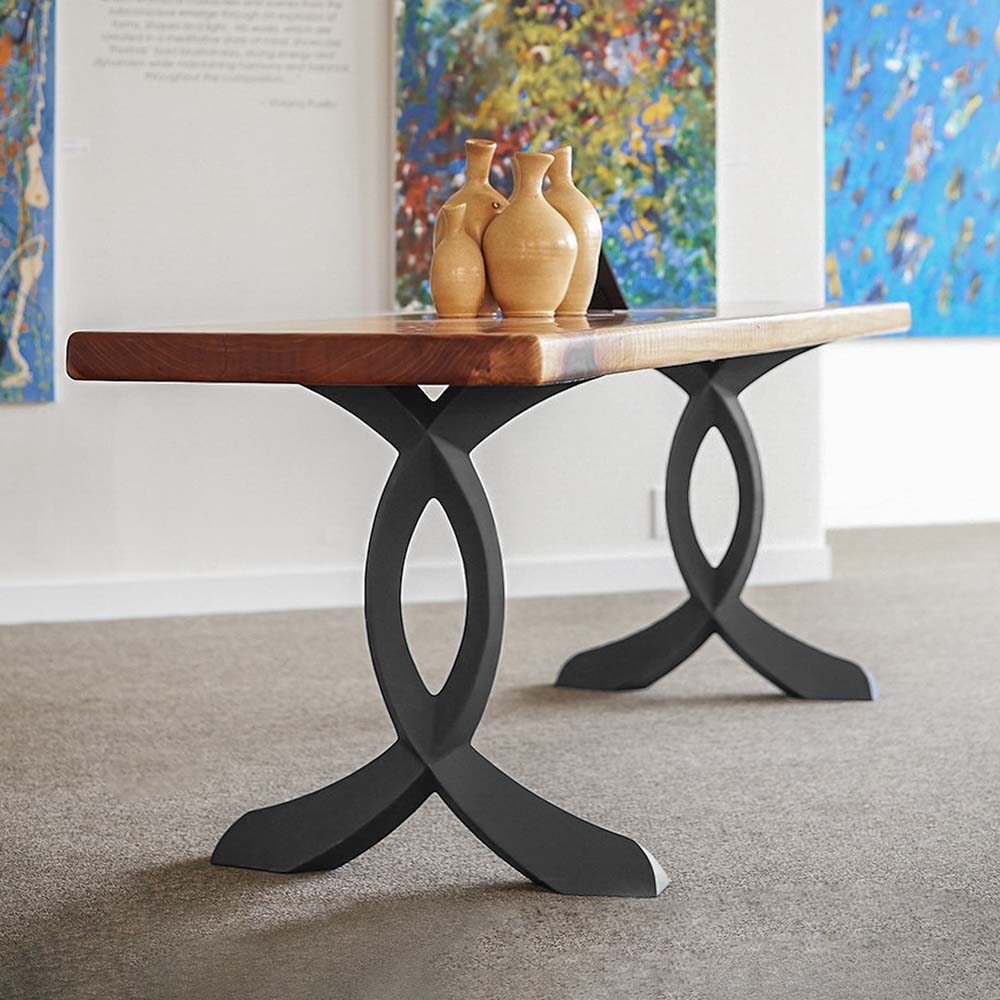A Comprehensive Look at Table Leg Styles: Locating the Suitable Match
Picking the ideal table leg style is important for both visual charm and functional functionality. Conventional 4 legs use classic sophistication and stability, while the pedestal base gives raised legroom and a modern appearance. For those with larger tables, trestle legs make certain tough assistance, whereas hairpin legs present a mid-century modern-day vibe with their minimal layout. The x-shaped legs mix contemporary style with improved stability. Each of these options brings unique benefits, making the choice greater than just a matter of preference. Explore additionally to find which design completely enhances your dining room and way of life.
Conventional 4 Legs
Among the numerous types of dining table leg designs, the traditional four-leg style remains a classic choice for lots of houses. 4 legs give balanced support, making sure the table stays steady and qualified of birthing substantial weight (dining room table legs).
From a visual viewpoint, the standard four-leg design can be conveniently adjusted to numerous indoor styles. Whether crafted from wood, steel, or a combination of products, these legs can be delicately sculpted, streamlined and minimalistic, or anything in between. Their convenience allows them to match both rustic and contemporary setups effortlessly.
Moreover, the simple framework of the four-leg layout assists in convenience of activity and positioning within an area. Unlike even more facility bases, this design lessens blockages, supplying adequate legroom for restaurants. In recap, the typical four-leg eating table leg design weds enduring style with functional performance, making it an astute selection for those looking for both kind and feature in their dining furnishings.
Stand Base
Usually celebrated for its elegant and space-efficient design, the pedestal base is a notable alternative to the traditional four-leg configuration in table leg styles. This distinct base normally features a solitary central column sustaining the tabletop, which can vary in kind, from ornately carved timber to sleek, modern-day steel. One of the main advantages of the stand base is its capability to optimize legroom and seating adaptability. Without corner legs, restaurants are managed greater freedom of motion, making it a suitable choice for round and oval tables that advertise even more intimate and inclusive gatherings.
The main column itself uses a canvas for detailed designs and imaginative expressions, adding an aspect of aesthetic interest underneath the table. In summary, the pedestal base integrates performance with style, making it a fine-tuned and practical option for diverse dining environments.
Trestle Legs
Trestle legs give a durable and timeless foundation for dining tables, defined by their horizontal cross-bracing and strong support beam of lights. Originating from middle ages times, this layout has actually advanced yet kept its crucial structure, making it a seasonal fave in both typical and modern setups. The central trestle beam, often supported by two or more vertical blog posts, uses exceptional security, permitting bigger table sizes without the requirement for extra legs.
A considerable benefit of trestle leg tables is the enough legroom they supply. Unlike tables with 4 corner legs, the lack of obstructions at the table's sides provides unobstructed room for chairs and diners, improving comfort and ease of access. This makes trestle tables excellent for accommodating larger celebrations, whether in a dining-room or a reception hall.
From rustic farmhouse to smooth modern layouts, trestle legs can be tailored to fit specific preferences. Their enduring appeal and functional benefits make trestle legs an engaging choice for those seeking both design and functionality in their eating table.
Barrette Legs

The allure of barrette legs hinges on their simpleness and flexibility - dining room table legs. Readily available in a series of materials, including steel and brass, they can be finished in many shades to enhance different indoor styles. Whether coupled with a rustic wooden table top or a modern glass surface, hairpin legs easily blend performance with a touch of classic beauty
Toughness is one more noteworthy feature of hairpin legs. Regardless of their delicate look, these legs are Learn More crafted to bear considerable weight, making sure the dining table continues to be steady and secure. In addition, they are reasonably simple to mount, making them a preferred selection for DIY enthusiasts and expert furnishings manufacturers alike.
X-Shaped Legs

Created from materials such as steel, wood, or a combination of both, X-shaped legs can be tailored to match various layout preferences. Steel legs commonly lend a smooth and commercial feeling, suitable for loft-style apartments and modern eating spaces. On the other hand, wood X-shaped legs supply a warmer, much more rustic allure, appropriate for farmhouse or eclectic insides. The flexibility in products enables homeowners to personalize their dining tables to better fit their overall style scheme.
Moreover, the engineering behind X-shaped legs ensures also weight distribution, lessening the risk of wobbling and improving sturdiness. This makes them specifically well-suited for larger table that call for additional support. In essence, X-shaped legs blend practical design with modern appearances, making them a classic choice for diverse eating environments.
Verdict
A comprehensive understanding of table leg designs discloses the unique attributes and benefits of each style. Standard 4 legs supply security and classic allure, while pedestal bases give legroom and a streamlined look. Trestle legs make sure durable i was reading this assistance for bigger tables, and barrette legs present a mid-century modern aesthetic. X-shaped legs incorporate contemporary style with improved stability. Choosing the appropriate leg style makes certain both practical and aesthetic satisfaction in any kind of dining room.